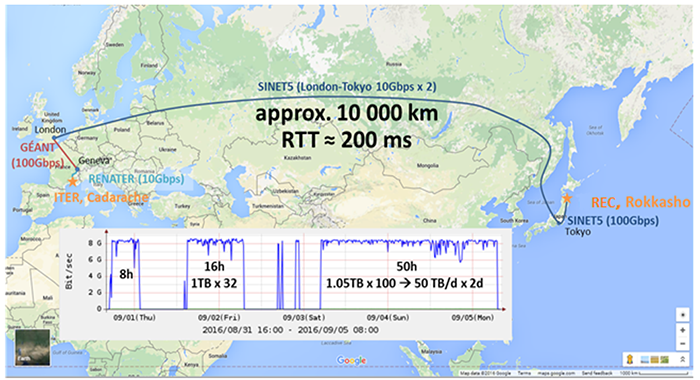HOME > Research Activities > Research Updates >
The Large Helical Device (LHD) is used not only by the National Institute for Fusion Science, but also jointly by researchers at universities throughout Japan. Further, when the International Thermonuclear Experimental Reactor (ITER) under construction at present is completed and operation begins, researchers around the world will begin to conduct collaborative research by utilizing ITER. In collaborative research that utilizes such a large device, it is important to prepare an environment in which researchers can participate in experiments at locations far away from the facility. Thus, what becomes necessary is the capability to send extremely large amounts of data, that is, “big data,” quickly to distant places. Here, we will introduce current efforts to make it possible to send big data at the world’s fastest speed to distant destinations and to make it possible to conduct collaborative experiments even from the other side of the world.
First, we will explain the problems in current network technologies. In current networks, when numerous users seek to send a message, data being sent can be destroyed or lost because of the collision of data, thus we confirm the sending of the data at the data source point and the arrival of the data at the delivery point. Because this confirmation of delivery is undertaken by receiving the message stating arrival completed from the delivery point, the longer the distance between the source of the transmission and the delivery point, the longer the transmission time will become. For example, the transmission time between Japan and Europe is as much as 0.2 seconds. Because the next data cannot be transmitted until delivery is confirmed, the result is that the data delivery speed slows significantly. This problem is particularly prominent in “big science” fields such as accelerators and elementary particles, astronomy, fusion, and others in which there is only one large device.
At the National Institute for Fusion Science, we are advancing with research for solving the problem of the slowing down of speed in cooperation with National Institutes for Quantum and Radiological Science and Technology and ITER Organization in the fusion field and with National Institute of Informatics (NII) in the information network field. By using the data transfer program called MMCFTP, which was developed recently at the NII, we simultaneously make accesses from several hundred times to several thousand times and have conquered the slowing of speed by adjusting the transfer speed constant as a whole. At present, we are continuously updating our world record long-distance data transfer speed. And in December 2017, we achieved the new world record of 231 gigabits per second. This is equivalent to sending 30 gigabytes of a Smartphone contract not in a month but in one second. This time, utilizing this MMFP, we actually conducted two experiments in which we sent big data to a distant location.
The first experiment was for transmitting data from ITER, in France, to the ITER Remote Experiment Center (REC) in Rokkasho, in Aomori Prefecture. We imitated ITER’s actual operation, and conducted an experiment to send data. The amount of data to be obtained from ITER upon commencing will be approximately 1 TB (1 terabyte = 1000 gigabytes), and at the peak will be estimated to have reached approximately 50 TB. (In the LHD, in 2013 in each experiment approximately 0.9TB of data was collected. This value, which approaches ITER, is the highest record in this field still at present. See back number 233.) The experiment at ITER is estimated to have been conducted one time every 30 minutes, and was operated successively without halt for 8 hours, for 16 hours, and for 50 hours (equivalent to two days with 3 shifts). We experimented with sending one terabyte of LHD data in order to verify whether or not sending data was possible. The result was a great success. Regarding the upper speed limit of 8 gigabytes each second that was estimated in advance, despite there being a great distance from southern France (ITER) to Rokkasho (REC), that is, approximately 10,000 kilometers, on average we achieved a nearly stable transfer speed of 7.2 gigabytes each second. In this experiment of 50 consecutive hours, the data transfer amount was 50 terabytes each day, and we established a world record for data transfer in one day over a long distance and over a continent.
Another experiment was a test to promptly send all acquired experimental data received each time by the LHD to collaboration researchers at distant sites. In the plasma experiments conducted in 2017, we instantaneously sent all experimental data from Toki (LHD) to Rokkasho (REC), and in an experimental cycle of one time every three minutes we confirmed that we could easily complete the transfer within two minutes. Subsequently, we completed the transfer of approximately 430 terabytes from the beginning of the LHD Experiment in 1998 until February 2018. Due to this type of long-term transfer experiment, we clarified again that not only high-speed data transfer programs such as MMCFTP, but also the speed of data preservation devices for reading and writing and the speed of intermediary devices are important.
The results gained from these two experiments are anticipated to contribute to research conducted on ITER and at REC, but also to distant site experiments on large-scale devices in Japan and abroad, beginning with the Large Helical Device.

Image : In the extended duration continuous data transfer experiment from ITER (southern France) to REC (Aomori Prefecture) which imitated the start of an ITER experiment data transfer experiment was conducted one time every thirty minutes, and operated successively without halt for 8 hours, for 16 hours, and for 50 hours. We achieved the world record of transferring 50 terabytes in one day.
